|
Related FAQs: Fishes of the
Tropical West Atlantic, Tropical West
Atlantic 2,
Related Articles: TWA
Invertebrates, Algae, Vascular Plants, Introduction to Fishwatcher's Guide
Series Pieces/Sections, Lachnolaimus maxiumus/Hogfish, Hogfishes of the Genus
Bodianus,
Fishes of The Tropical West
Atlantic: Bahamas to Brazil, Part 1
To: Part 2, Part 3, Part 4,
Part 5, Part
6, Part 7, Part 8, Part 9,
Part 10, Part
11,
|
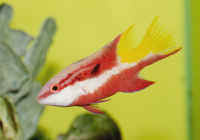
|
| Bob Fenner |
Cuban Hogfish
|
The Tropical West Atlantic (TWA henceforth), encompasses a huge area
of shallow marine waters from Massachusetts, during the warmest periods
of the year, on down to Brazil. You might presume that there are
enormous differences in the mix of life forms found along such an
expanse of sea. But by and large, much of the fish life detailed here
can be found in the Bahamas, Caribbean, down along the northern South
American east coast, and all the way past New Jersey in warm
months.
The TWA is the most visited and dived place in the world, with some
six million travelers a year. Not surprising for an area of dozens of
countries and hundreds of islands, the Tropical West Atlantic is a year
round destination. Excepting far northern and southern parts of
geography, the waters here range in the seventies to eighties F..
What's in this area of interest to saltwater aquarists,
collectors and the distribution businesses in-between them? Here is my
listing of what fishes are utilized currently, some notes regarding
their husbandry and appropriateness in our avocation, and a stab at
encouraging all to consider other species not presently employed.
Ecotype Statements
I've offered some broad strokes here in describing very
generally where the various fish groups and species are typically
found. Other authors have been much more specific in defining reef
geographies and particular niches, but I'll assure you that
duplicating biotopes is not essential. Indeed, almost all hobbyist
arrangements are a mish-mash of mixed species that would never meet in
the wild, and most get along just fine.
On the other hand, I cannot encourage you enough to go beyond the
simple statements offered here in investigating and doing your best to
mimic a physical and biological slice of the TWA (or any part of the
"real" world you'd like to recreate in miniature). The
printed works listed here, Internet, and actual travel to the area are
the best means of gaining knowledge of what makes up a given TWA
biotope.
Captive Suitability Scoring:
After long thought, investigation of others declared opinions, and
handling tens of thousands of these species I've come to a set of
"scores" for each on its likelihood of surviving the rigors
of aquarium care. Yes, to some degree this information is necessarily
historical (what has happened, may not be the general trend to come),
and is subject to "improvement" on the keepers side as a
consequence of providing larger, more stable quarters (like public
aquariums), and more diligent husbandry. But, by and large a relative
score of one (1) indicates the "highest and best"
survivability under captive conditions; let's say most of the
specimens of this species collected surviving more than three months. A
score of two (2) is indicative of a mortality of more than fifty
percent between one and three months. Lastly, and sufficient for our
purposes, a three (3) is the worst score, with more than 50% of the
species perishing before a months time of capture. I entreat you to
leave the latter group to the sea, or at least to study and provide the
best possible circumstances for these animals.
Family/Species Accounts of Fishes Suitable for
Aquariums Of the Tropical West Atlantic
Sharks, Subclass Elasmobranchii. Without a doubt the most
commonly traded shark species in the aquarium hobby is the Nurse Shark,
Ginglymostoma cirratum (family Ginglymostomatidae) (3)., a
usually docile gray to tan colored animal that spends a great deal of
time lying on the bottom under ledges. The problem in keeping the Nurse
is the same as for most shark species; they get big (several feet),
fast (depending on feeding to a degree), jump out (in all honesty, a
better way to die), all in all, requiring very large quarters and
special care. Another shark "utilized" from the area, and if
possible, even more of a shame, is the Lemon Shark, Negaprion
brevirostris, fittingly of the Requiem Shark family, Carcharhinidae
(3).. This species requires even larger quarters (several thousand
gallons) of circular configuration. Obviously both these sharks should
only be exhibited in Public Aquariums.
Ecotype for both species: All types, shallows to open water.
| Ginglymostoma cirrhatum (Bonnaterre 1788),
the Nurse Shark. Most often collected out of the tropical West
Atlantic as the most commonly (mis)offered shark species for
aquarium use, though found in the Eastern Atlantic and Eastern
Pacific coasts. To nearly fourteen feet in length (not a misprint).
Unbelievable to me that folks would offer or buy this animal in
place it in tiny systems. Jumps out or dies unhappily... Bahamas
and aquarium images. |
| Carcharhinus perezi (Poey 1876), the
Caribbean Reef Shark. Tropical West Atlantic, Florida to Brazil,
including the Gulf of Mexico. A large shark with a small first
dorsal fin which bears a small rear tip itself. Known to bite, but
not eat humans. To about ten feet in length. Here in the
Bahamas. |

|
| Sphyrna lewini (Griffith & Smith 1824),
the Scalloped Hammerhead. Found around the world in cool to
tropical waters. To thirteen feet in length. This visitor off
Hurghada, Egypt, Red Sea was about eight feet long. |
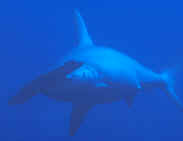
|
There are a few other species of Atlantic sharks; none of them
suitable for home aquariums. If you must try a marine shark, please
look at the few smaller Cat Shark (family Scyliorhinidae) (2) and
Bamboo Shark (family Hemiscyliidae) (2) species offered in the trade;
and do your husbandry homework in advance.
Of the several Rays, Order Rajiformes, found in the TWA a
single species is of use to aquarists. The Yellow Stingray,
Urolophus jamaicensis (2) is certainly not the only good-looker
amongst the handful of dorso-ventrally compressed cartilaginous fishes
found here, but it is the only one that stays small enough (to 2.5
feet) for aquarium use. Yes, they're venomous.
Ecotype: Found in shallow, sandy habitats, generally at least partly
covered.
| Dasyatis americana (Hildebrand &
Schroeder 1928), the Southern Stingray. Western Atlantic; New
Jersey to Brazil. To over six feet in diameter. Below: A full and
business end view of a specimen in Tobago in the Lower Antilles and
one in the Bahamas. |
| Manta birostris (Donndorff 1798), a/the
Manta Ray. The paddle-like extensions on the head used for
directing food into this filter feeders mouth. Third largest fish
species at more than 6.7 meters in width, two tons in weight.
Circumtropical. One at a cleaning station in Australia, another in
Hawai'i in shallow water shot by MikeK. |
 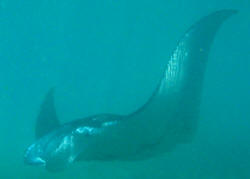
|
| Urobatis jamaicensis (Cuvier 1816), the
Yellow Stingray. Western Atlantic; North Carolina to Venezuela. To
thirty inches wide. Aquarium and Cozumel photos. |
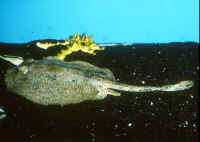 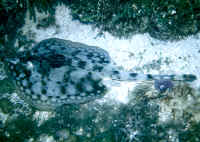
|
| Raja eglantiera Bosc 1800, the Clearnose
Skate. Western Atlantic; Massachusetts to the Gulf of Mexico. To
two feet in diameter. This one in the shallows in the Bahamas. |
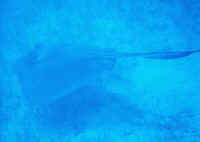
|
Morays, family Muraenidae. The reefs of the TWA are home to a
handful of moray eels, and almost all are offered for sale at times in
the trade. I break with other authors in my appraisal of all but one of
these animals. In my opinion, the Chain Moray, Echidna catenata
and Goldentail, Gymnothorax miliaris (1's), ought to be
considered for home aquarium use. It stays relatively small (about two
feet) and like other members of its genus, gladly accepts fresh and
prepared (or live) crustacean foods, leaving fish livestock alone.
Most of the other West Atlantic morays get too big, jump out too
readily and gladly eat their fishy tankmates (2).. Nevertheless,
because these "big nasties" are available we'll list them
here. The Spotted (G. moringa), Purple Mouth (G. vicinus), even
"monster" Green or Golden Moray Eels (G. funebris).
Other names, including the infamous "assorted" and
"miscellaneous" are applied to these and a few other eel
species imports. If you get one of these escape artists, watch your
hands and your piscine livestock!
Ecotype: Shallow to mid-depth reefs to bays, rocky habitats. Hide in
recesses by day, coming out at night to feed.
| Gymnothorax moringa Cuvier 1829, the Spotted Moray Eel.
Tropical eastern and western Atlantic coasts. To four feet in
length. Common in the wild. Bahamas and St. Thomas pix. An
easy-going species for aquarium use. |
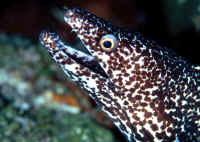 
|
| Muraena retifera (Goode & Bean 1882),
the Reticulated Moray. New England to Venezuela. To 60 cm. in
length. Feeds on fish, squid and crustaceans in the wild. Aquarium
photo. |

|
Snake eels, Family Ophichthidae. Two of the four species of
snake eels that occur on reefs in the TWA make their way into the trade
(along with a few Pacific ones). The Sharptail (Myrichthys
breviceps)(3). and Goldspotted Snake Eels (M. ocellatus)(3).
Are supreme escape-artists that should be avoided for aquarium use. If
you try a snake eel, assure yourself that the specimen is feeding.
Ecotype: Shallow bays to rocky reefs. These fishes are recluses by
day, foragers by night; and sand-burrowers that appreciate the same in
captivity.
| Myrichthys breviceps (Richardson 1844), the
Sharptail Snake Eel. Tropical West Atlantic. To a bit over three
feet in length. Rarely survives for any period of time in captivity
due to a lack of feeding, collateral damage from collection,
handling. Needs large, sandy-bottomed quarters, ghost shrimp, small
crabs for food. May eat mouth-size or smaller fish tankmates. Wild
photos below at night off of St. Lucia, and an aquarium image. |
Conger and Garden Eels, Family Congridae:
| Conger triporaceps Kanazawa 1958, the
Many-tooth Conger. Western Atlantic; Florida to Brazil. To a meter
in length. Found in association with rocky, coral bottoms. Bahamas
pic at night. |
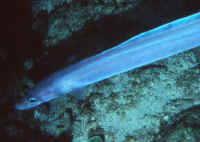
|
| Heteroconger longissimus Gunther 1870,
Garden Eels. Tropical Eastern and Western Atlantic. To 51 cm. Found
living in colonies near reefs in the sand in which they burrow,
retreat. Feed on plankton and detritus. |
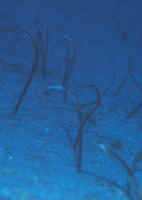
|
The Frogfishes or Anglers, Family Antennariidae. All seven
legitimate species of TWA frogfishes are utilized in the trade, though,
like their numbers in the wild, present only in small numbers. Rather
than being sold by the species, they are almost always offered as
"Assorted Caribbean" and "Colored: Caribbean/South
American" being one of a handful of possible species, with the
Wartskin (Antennarius maculatus) (2)., and Sargassumfish
(Histrio histrio) (2). possibly lumped in with the bunch or
identified seperately. Species identifications can be trying, with much
confusing overlapping of physical traits, color, and patterns; luckily
all these globose animals' care is similar. Providing cover for
perching and cryptic matching is desirable and one constant in their
husbandry: they will gladly inhale any/all other tankmates small enough
to get into their capacious maws. Yes, they can ingest fishes actually
longer than themselves.
Ecotype: The Sargassumfish is found floating about in its namesake
algal-weed. Other species inhabit reefs, sand to muddy shoals very
often matching their surroundings so well that divers pass them by
unaware of their presence.
| Histrio histrio (Linnaeus 1758), the
Sargassum Anglerfish, or if it were up to me, "The Incredible
Eater Upper"... To only 13 cm. but able to eat most any animal
near its length. Known from all tropical oceans, typically found
"floating" in kelp canopies or bits that are broken off.
Aquarium photos, first by RMF, second by Mike
Giangrasso. |
 
|
| Antennarius multiocellatus (Valenciennes
1837), the Long-lure Anglerfish. Tropical West Atlantic; Florida to
northern South America. Most common frogfish in the TWA, found
disguised around sponges. Fishing rod (illicium) about twice the
length of first dorsal spine. Feed on fishes and crustaceans. Eggs
laid in ribbon like masses. Here are two colored varieties in
Bonaire. |
| Antennarius striatus, Striated Frogfish.
Tropical West Atlantic and Indo-Pacific; South Africa to Japan and
New Zealand, in mud or sand bottoms, often associated with sponges.
To seven inches. Aquarium and N. Sulawesi
photos. Distinguished from the similar appearing A.
hispidus by its worm-like esca. Many pseudonyms (28) exist for
this species, including A. scaber. Males with more
tufts/camouflage than females. |
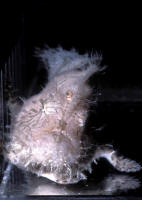 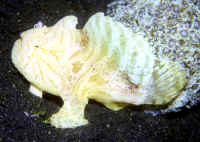
|
Toadfishes or Midshipmen, Family Batrachoididae (2). There
are two spectacular members of this family hailing from the TWA, but
both have very restricted ranges and are rarely available. These are
the Splendid Toadfish, Sanopus splendidus from Cozumel, and to
the south, the Whitelined Toadfish, S. greenfieldorum of Belize.
Two pug-ugly toadfishes that do make it into the hobby, though often
sold as "sculpins" (which they resemble somewhat) are the
Oyster Toadfish, Opsanus tau, and Sapo Cano, Thalassophryne
maculosa. These fishes should be handled with care (if at all).
Their anterior dorsal spines and preoperculum bear venom, and they will
bite other fishes and you.
Ecotype: Rocky to sandy bottoms hiding with just head exposed or
under the sand.
| Opsanus pardus (Goode & Bean
1880), the Leopard Toadfish. Tropical West Atlantic, Gulf of
Mexico. To fifteen inches in length. |
|
| Opsanus tau (Linnaeus 1766), the
Oyster Toadfish. Western Atlantic. Massachusetts to Florida.
To fifteen inches in length. One in the Florida Aquarium and
the other under a pier in Belize. |
 
|
| Sanopus splendidus Collete, Starck
& Phillips 1974, the Coral or Splendid Toadfish. Tropical
West Atlantic; endemic to Cozumel. To 24 cm. Cozumel
pic. |

|
|
Trumpetfishes, Family Aulostomidae: Though not as commonly
available as its Pacific counterpart, Aulostomus chinensis (3).
the single Atlantic Trumpetfish species, A. maculatus (3) is
making its way more and more frequently into pet-fish markets. This
"hide and seek" expert is a real master of deception,
changing color rapidly, hanging out amongst vertical elements, even
swimming in parallel, co-stalking with other predatory fishes.
Ecotype: Coral reefs, typically still in a vertical orientation.
Other tube-mouthed fishes, the Seahorses, Family
Syngnathidae. Cute, but amongst the most difficult marine fishes
to keep, the Seahorses from the TWA fare no better coming from here
than their congeners from the Indo-Pacific. Thankfully, the trade in
the tiny Dwarf Seahorse, Hippocampus zosterae (3). is but a mere
shadow of its previous years. The two larger endemics are not so
fortunate. The Slender or Longsnout (H. reidi) (3). and Lined
Seahorses (H. erectus) (3). both require specialized housing,
dedicated "species" biotopes with considerable effort at
culturing and preparing foods. Please don't attempt these animals
without knowing full well what you're getting into, and dedicating
the resources to their basic needs.
Ecotype: Amongst attached (gorgonians, seagrass) or floating
sargassum, in shallows.
| Hippocampus erectus Perry, 1810, the Lined
Seahorse. To 19 cm. in height. Numerous lines on head, possibly
down nape, body. Western Atlantic: Nova Scotia to Panama. Found in
Zostera beds and on gorgonians, even floating Sargassum. SIO
Aquarium photo. |

|
| Hippocampus zosterae Jordan & Gilbert,
1882, the Dwarf Seahorse. To 5 cm. in height. Very short snouts.
Western Atlantic: Bermuda, southern Florida (USA), Bahamas and the
entire Gulf of Mexico. Found in Zostera beds near shore. THE dwarf
seahorse of past comic book fame... only lives a year. Aquarium
image. |

|
| Cosmocampus sp. One of twenty or so species
of Pipefishes in the Tropical West Atlantic. This one off of St.
Thomas. |
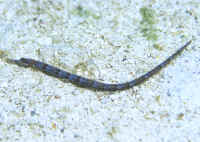
|
Squirrelfishes and Soldierfishes, family
Holocentridae (2).. At times two or three species of
squirrels found here are collected and sold in the trade. Most commonly
encountered by far are the Longjaw Squirrelfish, Holocentrus
ascensionis; the Longspine Squirrelfish, H. rufus; and the
Blackbar Soldierfish, Myripristus jacobus. All make moderate, if
secretive aquarium specimens. Two things to keep in mind with these
fishes, they're very spiny and large-mouthed. Watch your handling
of them and make sure tankmates are more than mouth size.
Genus Holocentrus:
| Holocentrus adscensionis
(Osbeck 1765), Squirrelfish. tropical western and eastern Atlantic.
A regular offering out of the TWA, and a beautiful addition when
small, but grows to about two feet if fed abundantly. This one
photographed in the Bahamas. 4-40 feet. |
 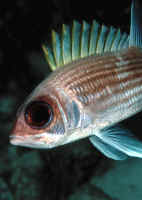
|
| Holocentrus coruscus (Poey
1860), Reef Squirrelfish. Tropical western Atlantic; Florida to
northern South America. A delightful offering out of the TWA. To
six inches overall length. Bonaire pic taken during a night
dive. |

|
| Holocentrus rufus (Walbaum
1792), Longspine Squirrelfish. Another steady catch for the
pet-fish trade out of the tropical West Atlantic, at a much more
manageable maximum length of fourteen inches (in the
wild). Note white tips of hard dorsal fin spine membranes.
Bahamas pix. 4-100 feet. |
 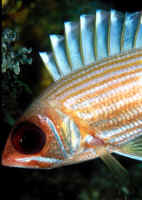
|
Genus Myripristis:
| Myripristis jacobus Cuvier
1829, the Blackbar Soldierfish. Tropical West Atlantic. To ten
inches maximum length. These images shot in the Bahamas. 15-60
feet. |
 
|
Ecotype: Shallow to deep reefs under overhangs and in caves by day,
foraging outside by night.
Scorpionfishes, Rockfishes, Family Scorpaenidae: Most of
these lionfish relatives come out of the Indo-Pacific, but occasionally
an Atlantic Scorpionfish is sold under the "miscellaneous"
moniker. Most often this is the drab Spotted Scorpionfish, Scorpaena
plumieri (2) , a real "stealth" fish if ever there
was one. For completeness sake, we'll mention the Bandtail
Searobin, Prionotus ophryas (2); sold as a Scorpion, though
it's a member of the Searobin (or Gurnards) family, Triglidae.
Ecotype: Like their second common name, Rockfishes are found on the
bottom, generally motionless amongst the rocks. Virtually undetectable
to prey and divers.
| Scorpaena plumieri mystes Bloch 1769, the
Spotted Scorpionfish. To eighteen inches in length. Western
Atlantic: Massachusetts, northern Gulf of Mexico to southern
Brazil, Ascension and St. Helena. Found sitting on rocky bottoms
5-55 meters of depth... ambushing fishes and crustaceans for food.
Occasionally imported as an aquarium species. Bahamas pix of a view
above and close-up. |
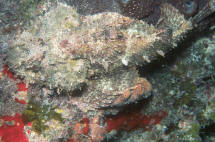 
|
| Bigger PIX: The images in this table are linked
to large (desktop size) copies. Click on "framed" images
to go to the larger size. Here's a invasive, non-indigenous Volitans Lion in
Cozumel... |
|

|
To: Part 2, Part
3, Part 4, Part
5, Part 6, Part
7, Part 8, Part
9, Part 10, Part
11,

